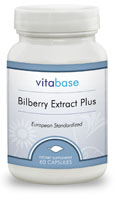| |
Bilberry |
|
| Bilberry (vaccinium myrtillus) is a short, shrubby perennial plant that inhabits the woods and forest meadows of Europe, western Asia, and the Rocky Mountains of North America. The bilberry is a member of the Ericaceae family. The European species vaccinium myrtillus is known as bilberry, whereas the North American variety, called Vaccinium corymbosum, is known as blueberry. Bilberry is a shrub that grows to about 16 inches in height. It has oval, pointed leaves and small pink and white flowers, which bloom from April through June. As with many other plants that belong to the same plant family (Vaccinium), bilberry bears edible fruits similar to those found on the American blueberry bush. The fruits are eaten fresh, or are usually made into jams, juices or pies. They have therapeutic uses in herbal medicine. This herb is commonly used to fight eye fatigue and eyestrain by supporting and strengthen the capillaries that feed the eye nerves and muscles. |
| |
Active constituents of bilberry |
|
| Bilberry contains rich source of flavonoid compounds, known as anthocyansides. Anthocyanosides are extremely potent antioxidants that fight free radical damage, which can destroy cell membranes and allow pathogens to damage the delicate organelles that live inside each of cells and cause disease. Antioxidants are substances that help cells in the body resist and repair damage. Anthocyanosides stimulate circulation and help promote healthy eye function. Anthocyanosides speed the regeneration of rhodopsin, the purple pigment that is used by the rods in the eye for night vision. Bilberry also contains tannins, sugars, fruit acids, glucoquinone, glycosides, arbutin, pectins, vitamins (thiamin, and vitamins A and C), and minerals (especially iron, manganese, phosphorus, zinc, magnesium, potassium, selenium). |
| |
Medicinal uses and health benefits of bilberry
|
| |
|
Bilberry is included in the treatments for many types of retinopathy and is also used for eye fatigue, poor night vision, and
nearsightedness. Bilberry improves the circulation and helps improve night vision and helps fight blurred vision, improve blurred vision, and nearsightedness. Bilberry helps the body to produce rhodopsin more quickly. Rhodopsin is a pigment found in a part of the eye called the retina. Bilberry may also help slow the progression of cataracts, a clouding in the eye's lens that is common in older people.
The dried berries and leaves of bilberry have been recommended for a wide variety of conditions, including scurvy, urinary tract infections, kidney stones, and diabetes. Bilberry has antioxidant properties. Antioxidants may decrease free radicals which cause oxidation in the body. Bilberry may help manage disorders associated with poor circulation and damaged capillaries such as Raynaud's syndrome, varicose veins, spider veins, nosebleed and bleeding gums. Bilberry is an antiseptic and astringent. It is used successfully as a mouthwash, for treating diarrhea, and for reducing varicose veins. It also strengthens connective tissue. Its use can interfere with iron absorption. Other uses of bilberries include treating cystitis, enteritis and spasmodic colitis, possibly due to its ability to inhibit the adhesion of E. coli in the bladder and intestine. |
|
| |
Side effects, precautions, interactions of bilberry |
|
| Bilberry fruit extract has no known side effects when taken at recommended doses. Since the leaves are known to lower blood sugar levels, insulin-dependent diabetics should not take this herb without professional guidance. Sustained overdoses of bilberry leaves can lead to malnutrition, low levels of red blood cells, and yellowing of the skin and whites of the eyes. Do not use the leaves for longer than three weeks at a time. The high tannin content of bilberry leaf could possibly cause digestive problems. |
|
|
|
|
